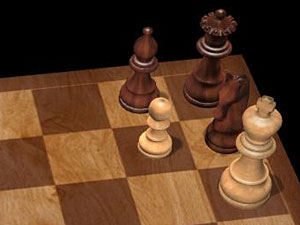
The pawn is the soul of the game
By Siegfried Hornecker
As this is our first episode of the “Study of the Month”, I would like to introduce the idea behind this column. The World Federation for Chess Composition is the governing body for all kinds of chess composition, including endgame studies. There was a selection of the “Study of the Year” each year which was supposed to show the most appealing recent study to the general public, which was presented, also on ChessBase, each year. But as this failed to draw the attention it should, John Nunn and Yochanan Afek came up with the idea of presenting some good older studies which might not be well known, but demonstrate the artistic side of this genre to the audience, once a month.
At the same congress where this was suggested, Afek also told a heartwarming story of himself seeing an elder man and a boy – supposedly father or grandfather and son – solving or replaying an endgame study, showing their surprise at almost each move. Yochanan Afek was also surprised. This was his own study on their board.

[Event "4.c The Problemist #1076"] [Site "?"] [Date "2012.??.??"] [Round "?"] [White "Afek, Yochanan"] [Black "White to play and win"] [Result "1-0"] [SetUp "1"] [FEN "5n1k/5P2/5p1B/q2bPKn1/8/8/1R6/3Q4 w - - 0 1"] [PlyCount "21"] [EventDate "2012.??.??"] 1. Bg7+ $1 (1. Bxg5 $2 fxg5 2. Qh5+ Kg7 3. Qxg5+ Kxf7 4. Qf6+ Kg8 5. Rh2 (5. Rb8 Qc5) 5... Be6+ 6. Kg5 Nh7+ 7. Rxh7 Qd2+ 8. Qf4 Qxf4+ 9. Kxf4 Kxh7) 1... Kxg7 (1... Kh7 2. Qh5+ Kxg7 3. exf6#) 2. exf6+ Kh8 (2... Kxf7 3. Qh5+ Kg8 4. Qxg5+) 3. Qh5+ Ngh7 4. Qxh7+ $1 Nxh7 (4... Kxh7 5. Rh2#) 5. Rb8+ Nf8 6. Rxf8+ Kh7 7. Rh8+ $1 Kxh8 8. f8=Q+ Bg8+ 9. Kg6 $1 Qc7 10. Qg7+ $1 Qxg7+ 11. fxg7# 1-0
As Philidor once said, the pawn is the soul of chess. The Saavedra study is a very famous example for another struggle where a single pawn wins ingeniously, but it will also be well known to the readers, so as this month’s study of the month I chose a pointed play that ends in a pawn drawing against probably the most possible material in a still endgame-like position.
The following study is not only outstanding because a correction was provided by one of the authors – the other one had died in 1973 already – 40 years later, but we will see soon for what other reason as well.

[Event "Shakhmatnaya Moskva (correction)"] [Site "?"] [Date "1958.??.??"] [Round "?"] [White "Kuznetsov/Sakharov, Anatoly G / Boris"] [Black "White to play and draw"] [Result "1/2-1/2"] [SetUp "1"] [FEN "6B1/b4pB1/1n4P1/3b3P/7K/2P5/p7/7k w - - 0 1"] [PlyCount "21"] [EventDate "1958.??.??"] {As Black currently wants to promote his pawn, White must open the diagonal to protect a1. Black, however, will close that diagonal again, requiring White to waste a tempo and winning the bishop on g8.} 1. c4 ({Hopeless is} 1. gxf7 $2 Bxf7 $1 2. c4 (2. Bxf7 a1=Q $19) 2... Bxg8 $19 {as compared to the main variation White has lost Pg6.}) 1... f6 $1 2. Bxf6 ({The zwischenschach} 2. Bxd5+ $2 {is too clever, as} Nxd5 {would protect f6. White also has no other moves that make any sense, so he must sacrifice his bishop.}) 2... Bxg8 { The next White move seems obvious, but even in such a situation, as in over-the-board play, one must always look at all possibilities, no matter how exotic they are. So can White do anything else? Any moves by the king just waste time, other moves are entirely pointless. Only one move remains:} 3. h6 { At first glance, is this not a clear win? After all, what can Black do? As will become clear, he can build a double threat, to stop his opponent/^s pawn and bring his own pawn forward, with the possibly difficult to find move...} Nd7 $1 4. h7 $1 {The only option White has is to push his pawn immediately. Now Black has several ideas, but - as the variations tell, it is best to get rid of Ba7 entirely to enable the newborn queen to protect a8.} ({Any indifferent move of the bishop will allow 4...Nf8, for example.} 4. Bb2 $2 Nf8 $1 $19 {and because Pg6 is under attack, White can't just play} 5. h7 {because of possibilities to exchange the black squared bishops, as only one example with the trick} Nxg6+ 6. Kg5 Bxh7 7. Kh6 Nf8 8. Kg7 Bd4+ 9. Bxd4 Ne6+ 10. Kxh7 Nxd4 $19 {and White ran out of luck.}) ({Trying to protect f8 with} 4. Bg7 Nf8 5. Bxf8 a1=Q $19 {gives even less resistance.}) 4... Bf2+ $1 (4... Bxh7 { leads to a drawn endgame after} 5. gxh7 Nf8 $1 6. h8=Q $1 ({but not} 6. h8=N $2 Ne6 $1 {and Black will win after all}) 6... Ng6+ 7. Kg3+ Nxh8 8. Bxh8 {and what Dvoretzky in his Endgame Manual calls a (+)bodycheck[+] draws for White as Black can/^t promote his pawn without having to exchange it for the bishop.} Kg1 9. Kf3 Kf1 10. Ke4 Ke2 11. Kd5 $1 $11) ({Of course taking the bishop immediately loses after} 4... Nxf6 5. h8=Q a1=Q (5... Bd4 6. Kg3+ Kg1 7. Qh2+ Kf1 8. Qxa2 $18 ({from a practical point easier than} 8. Kf3 Bxc4 9. Qh1+ Bg1 10. Qg2+ Ke1 11. Qxg1+ Kd2 12. Qd4+ $18)) 6. Kg3+ Bh7 (6... Kg1 7. Qh2+ Kf1 8. Qg2+ Ke1 9. Qh1+ $18) 7. Qa8+ $1 $18 {and a8 is unprotected because of Ba7.} ({ Of course,} 7. gxh7 $2 Ne4+ {loses immediately and instead of Ne4+ Black could even checkmate in three moves, which is left to the readers to find as a small tactics training.})) 5. Kg5 $1 (5. Kh3 $2 Be6#) (5. Kg4 $2 Nxf6+ $19 ({or} 5... Bxh7 6. gxh7 Nxf6+ $19)) 5... Bh4+ $1 ({Black must close the h-file, as} 5... Nxf6 6. h8=Q+ {with check would even win for White.}) 6. Kxh4 {Black now can execute his plan and seemingly win.} ({It is of note that White can/^t divert as} 6. Kf5 $2 Bxh7 ({or} 6... Be6+) 7. gxh7 Bxf6 {loses.}) 6... Nxf6 $1 7. h8=Q a1=Q {White seems completely lost. Any king move loses the queen, and otherwise White is just two pieces down.} 8. Kg5+ $3 {White decides to lose the queen immediately, as he has an ingenious trap.} ({After} 8. Kg3+ $2 Bh7 $1 {there is no check on the a-file, so} 9. gxh7 Ne4+ {loses the queen.}) 8... Nh7+ $1 {[#] It is over!} 9. Kh6 $3 ({Neither} 9. Qxh7+ Bxh7 10. gxh7) ({nor} 9. gxh7 {can put up any more resistance.}) 9... Qxh8 {Black is a queen and two pieces up. But just once in a blue moon, a miracle happens...} ({The pieces are tied up, so} 9... Qc1+ 10. Kg7 {is a draw.}) ({A funny repetition of the moves is} 9... Nf6 10. Kg5+ $1) 10. g7 $3 {Yes, it is over, but not in the way Black imagined. [#] He has queen, bishop, knight and the right to move against a single pawn (or two if you count in Pc4, which is irrelevant for the final picture), more than enough material to win. And yet it is a draw! What an incredible position!} Qxg7+ 11. Kxg7 {White wins another piece, even after taking the queen. Philidor would surely be proud of this pawn! Anatoly G. Kuznetsov (1932 - 2000) was a Soviet Master of Sports (1961) and International Master for Chess Composition (1990). He worked as a journalist and also promoted chess studies in numerous articles. Boris Andreevich Sakharov (1914-1973) was a Soviet scientist. He was delegate and vice president to the international chess composition organisation PCCC (today: WFCC). He "did not favour solutions longer than 10 moves" (quote from EG 104).} 1/2-1/2
|

You probably know that you can move pieces on the replay board to analyse, and even start an engine to help you. You can maximize the replayer, auto-play, flip the board and even change the piece style in the bar below the board. At the bottom of the notation window on the right there are buttons for editing (delete, promote, cut lines, unannotate, undo, redo) save, play out the position against Fritz and even embed our JavaScript replayer on your web site or blog. Hovering the mouse over any button will show you its function. |
 |
About the author
Siegfried Hornecker (*1986) is a German chess composer and member of the World Federation for Chess Composition, subcommitee for endgame studies. His autobiographical book "Weltenfern" (in English only) can be found on the ARVES website. He will present an interesting endgame study with detailed explanation each month. |



























